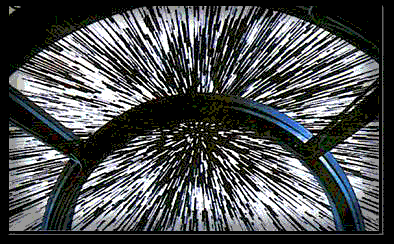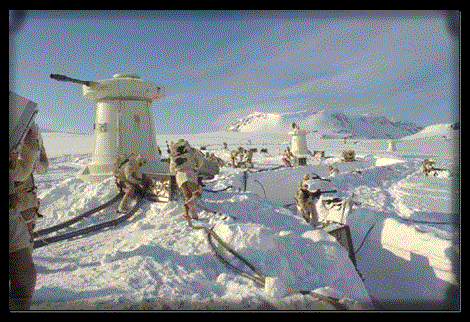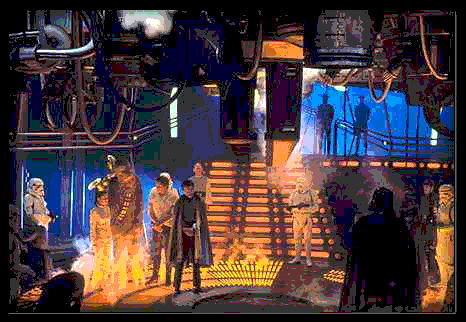|
|
Han Solo's signature BlasTech DL-44 heavy blaster pistol benefits from a highly illegal military power cell and customized energizer circuitry for maximum blast impact. This heavy-duty performance is enough to tear huge chunks from the adobe walls of a desert planet docking bay, and more than enough to permanently discourage the average Rodian opponent. After the Battle of Yavin, Solo had fitted his trusty DL-44 with an improved silver flash suppressor and a couple of other military components acquired from his new Rebel friends. Solo's modified pistol is a formidable weapon, and his quick-draw skills are honed by long practice with remotes and against living opponents. Shortly before the Rebels set up their base on the ice planet Hoth, Luke Skywalker began using a BlasTech DL-44 blaster pistol similar to that favored by his friend Han Solo. |
|
|
The standard Imperial sidearm is the BlasTech E-11 blaster rifle. This weapon has a three-position stock which allows for optimum bracing during use. Entrenched field troopers typically lock the stock in its fully open position for protracted firing on a constant target point. In full assault or unpredictable situations where agility is key, the stock is kept folded in its fully closed position, as seen here for the escort of a Rebel prisoner. Imperial blasters are substantially more powerful than most civilian sidearms and can often penetrate the combat armor worn by stormtroopers. Captured weapons in the hands of Rebel elements can lend significant power to the opposition. |
|
|
The traditional terror weapon of Tatooine's desert Sand People (or Tusken Raiders) is the dreaded gaderffi, or gaffi stick. This deadly, axe-like weapon is fashioned from metal scavenged from wrecked or abandoned vehicles and spaceships that end up in the Tatooine wastes. Luke Skywalker encounters the gaffi stick at uncomfortably close range in the Jundland Wastes. When the stormtroopers destroyed the Jawa sandcrawler, they left gaffi sticks scattered around the battle site to make it look like a Tusken Raider attack. |
|
|
In essence a blade of pure energy capable of cutting through almost anything, the lightsaber is the noble yet powerful weapon which the Jedi Knights have masterfully wielded for thousands of years. Although each lightsaber is unique, the weapon's basic design remains the same. The handle, twenty-four to thirty centimeters long, holds a power cell as well as one or more crystals - seldom more than three - whose purpose is to focus the energy released by the power cell into a tight, blade-like beam. The blade's color depends on the nature of the jewel it springs from, and while its length is fixed in the case of a single jewel lightsaber, lightsabers equipped with multiple crystals can have their length varied by rotating a knob which allows the focusing crystal activator to subtly modify the refraction pattern between the gems. After losing the lightsaber that had been his father's in a duel with Darth Vader, Luke Skywalker, in accordance with tradition, builds his own lightsaber as one of the final steps of his Jedi training, before he confronts Jabba the Hutt in his palace on Tatooine.
|
|
|
Darth Vader's grim black attire is a life-support system, his labored mechanical breathing the sound of a walking iron lung. Critically injured in a lightsaber battle with Obi-Wan Kenobi years ago, Vader became "more machine than man," kept alive only by the devices built into his suit. The fearsome visage of his breath mask reflects the dark identity that he assumed after his fall from the light side of the force. Vader can only remove his mask in a special hyperbaric chamber, such as this one on board his Star Destroyer Executor. Allowing no one to assist him, Vader relies on mechanical devices to remove and replace his helmet and metal breath screen. |
|
|
A technology whose origin remains the subject of heated debate, the hyperdrive is an engine - powered by fusion generators - which allows a spacecraft to enter hyperspace, an alternate dimension where travel at many times the speed of light ceases to be an impossibility. Journeys that would require months or years in normal or "realspace" zip by in a matter of weeks or hours, making distant star systems easily accessible. Travel through hyperspace is a serious and very delicate operation. Objects in realspace cast a hyperspace shadow, acting as obstacles in hyperspace as well. While the pilot of a starship hurtling through realspace might have enough time to react to a planet or asteroid in his craft's trajectory, the incredible speeds reached by a spacecraft in hyperspace render human reflexes absolutely useless. Hyperspace-travelling starships are thus equipped with a nav computer or an astromech droid, whose job is to calculate with the utmost precision the entry and exit coordinates, as well as the speed and duration of the trip, based on hyperspace maps. Should a previously uncharted space body show up on the ship's itinerary, mass shadow sensors would detect its hyperspace shadow and automatically shut down the hyperdrive, bringing the ship back into realspace. Ships that have their hyperdrive damaged or disabled risk ending up stranded in deep space, unable to reach a spaceport or inhabited planet before they run out of supplies. In such a situation, a hyperdrive backup can mean the difference between life and death. Although most backups are very slow, their performance is still far ahead of the most powerful sublight drives. The hyperdrives of Han Solo's ship, the Millennium Falcon have been greatly modified to make it a dangerously fast space transport; but as a result the hotrod starship is highly prone to engine failure.
|
|
|
Also know as 'realspace drive', the sublight drive is the basic propulsion system found aboard every starship. It is used either to propel a spacecraft within a star system, or to bring it far enough from any planet so it can successfully and safely jump to hyperspace. During the landing cycle, a starship's sublight drive is supplemented by a repulsorlift drive, allowing the ship to maneuver with heightened precision within the planet's atmosphere. Unlike hyperdrives, sublight drives cannot bring a spacecraft to exceed the speed of light (hence their name). Thus, starships equipped only with a sublight drive - like the Imperial TIE Fighter - are not designed to operate at great distances from their home base. Such craft must be carried to deep space destinations by a capital ship, like an Imperial Star Destroyer. The most common type of sublight drive is the Hoersch-Kessel (H-K) ion drive, which propels a ship by having its reactors generate a stream of charged particles. The A-wing and TIE Interceptor sport some of the most powerful sublight drives ever manufactured. Their high-velocity capabilities are spectacularly apparent during the attack on the second Death Star.
|
|
|
The DF.9 Anti-Infantry turret battery stands ready to defend Rebel troops on Hoth from invading forces. This model is designed to be effective against infantry and small vehicles such as speeder bikes and skirmishing or scout craft. The battery is no match for the full-strength Imperial battle armor cladding the AT-AT walkers, however, and the Rebels knew that at best they would fight a delaying action from the snow trenches. While the turret gun incorporates a proton shield generator and laser armor, the heavy blast cannons of the Imperial walkers pack a devastating punch. As the Imperial Blizzard Force closed range on the Rebel snow trenches, the defensive emplacements and their crews inside were blasted and destroyed. This schematic of one variant of the turret gun indicates its principal features. |
|
|
Carbon freezing chambers are used for the process of storing Tibanna gas in carbonite to preserve it while it is being transported over long distances. A number of such chambers are constantly in use in Bespin's Cloud City. In the freezing process, the gas is pumped into the chamber where it is mixed with molten carbonite, then flash-frozen to cool the carbonite into a solid block. The gas is released later at its destination or at a processing center. But the chamber might have other, unintended uses.
|








